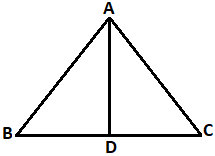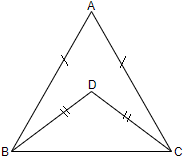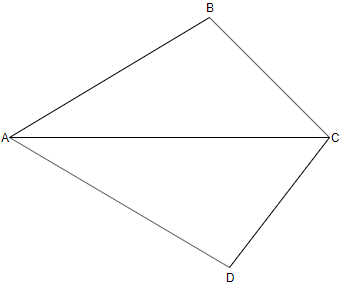Triangles - Test Papers
CBSE Test Paper 01
CH-7 Triangles
If all the altitudes from the vertices to the opposite sides of a triangle are equal, then the triangle is
Equilateral
Isosceles
Scalene
Right-angled
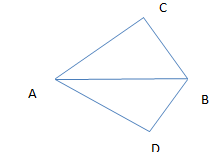
In the above quadrilateral ACBD, we have AC = AD and AB bisect the ∠A .Which of the following is true?ABC ABD
C = D
All are true
BC = BD
AD is the median of the triangle. Which of the following is true?
AC + CD < AB
AB + BD < AC
AB + BC + AC > AD
AB + BC + AC > 2AD
In the adjoining Figure, AB = AC and BD = CD. The ratio ABD : ACD is
It is 1 : 1
It is 1 : 2
It is 2 : 3
It is 2 : 1
In the adjoining figure, . If BAC = and ABC = then ACD is equal to
- Fill in the blanks:
In a , AB = 5 cm, AC = 5 cm and equals to ________.
- Fill in the blanks:
An angle is 4 time its complement, then the measure of the angle is ________.
Find the measure of each exterior angle of an equilateral triangle.
Compute the value of x of the following given figure:
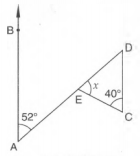
Prove that ABC is an isosceles, if Altitude AD bisects ∠BAC.
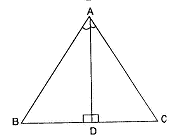
In figure, if AB DC and P is the mid-point of BD, prove that P is also the mid-point of AC.

In Fig, it is given that AE = AD and BD = CE. Prove that .
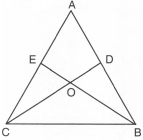
In figure, AD = AE and D and E are points on BC such that BD = EC. Prove that AB = AC.
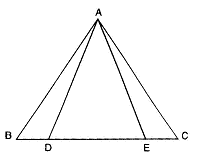
Show that the difference of any two sides of a triangle is less than the third side.
ABCD is quadrilateral such that AB = AD and CB = CD. Prove that AC is the perpendicular bisector of BD.
CBSE Test Paper 01
CH-7 Triangles
Solution
- (a) Equilateral
Explanation: In an equilateral triangle all the altitudes,sides, angles, perpendicular bisectors, medians and angular bisectors are equal. - (c) All are true
Explanation: In triangle ABC and ABD ,we have
AC = AD
AB = BAD
AB = AB
By SAS ,we have
ABC ABD
Hence, we have BC = BD and C = D.
So,all the given options are true. - (d) AB + BC + AC > 2AD
Explanation:
In triangle ADB
AB + BD > AD
In triangle ADC
AC+DC > AD
Adding both
AB + AC + BD + DC > 2AD
Now BD + DC = BC
So, AB + AC + BC > 2AD - (a) It is 1 : 1
Explanation:
In ABC
AB = AC
∴ ABC = ACB(angles opposite to equal sides of a triangle are equal)......1
in ΔDBC,
DB = DC,
∴ DBC = DCB(angles opposite to equal sides of a triangle are equal)......2
subtract 2 from 1
ABC - DBC = ACB - DCB(equals subtracted from equals gives equal)
= ABD = ACD
divide both the sides by ACD
= 1
ABD : ACD = 1 : 1 - (a)
Explanation: In triangle ABC, BAC = 30o and ABC = 100o (Given)
BAC + ABC + BCA = 180o
BCA = 50o
Also ∠ACD = 50o (Since, △ABC≅△ADC) 65o
72
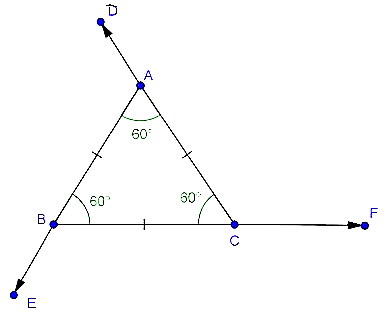
ACF = ABC + BAC [ Exterior angle = sum of opposite interior angles]
ACF = 60o + 60o = 120o
Similarly, BAD = 120o and CBE = 120oBAE = EDC = 52o (alternate angles)
DEC = x = 180o - 40o - EDC (because sum of all angles of a triangle is 180o)
= 180o - 40o - 52o
= 180o - 92o
= 88oIn ABD and ACD,
∠BAD = ∠CAD ...... [Given]
AD = AD ...... [Common]
∠ADB = ∠ADC . . . [Each 90o]
ABDACD = ...... [ASA axiom]
AB = AC . . . .[c.p.c.t.]
ABC is an isosceles triangle.AB DC and DB intersect them
BDC = DBA ...[Alternate angles]
In DPDC and D PBA
PD = PB ...[As P is the mid-point of BD]
PDC = PBA ...[As proved above]
DPC = BPA ...[Vertically opposite angles]
DPDC DPBA ...[By ASA property]
PC = PA ...[c.p.c.t.]
P is the mid-point of AC.
Given: AE = AD and BD = CE.
To Prove : △AEB≅△ADC
Proof: We have
AE = AD and CE = BD
AE + CE = AD + BD ..... (i)
AC = AB ...(ii)
Thus, Consider and ADC, we have
AE = AD [Given]
[Common]
and, AC = AB [ From (ii)]
[ by SAS criterion ]
Hence provedIn ADE,
AD = AE . . . [Given]
∠AED = ∠ADE . . . .[∠s opposite to equal side of a ADE ]
180o – ∠AED = 180o – ∠ADE
∠AEC = ∠ADB
In ADB and AEC,
AD = AE . . . [Given]
BD = EC . . . [Given]
∠ADB = ∠AEC . . . .[From (1)]
........ [By SAS property]
AB = AC ....... [c.p.c.t]To Prove:
Construction: Take a point D on AC such that AD = AB. Join BD.
)
Proof: In ABD, side AD has been produced to C.
3 > 1 [ Exterior angle of a is greater than each of interior opp. angle] ...(i)
In BCD, side CD has been produced to A.
2 > 4 [ Exterior angle of a is greater than each of interior opp. angle] ...(ii)
In ABD, we have
AB = AD
2 = 1 [Angles opp. to equal sides are equal] ...(iii)
From (i) and (iii), we get
3 > 2 ...(iv)
From (ii) and (iv), we get
3 > 2 and 2 > 4
3 > 4
BC > CD [Side opp to greater angle is larger]
CD < BC
AC - AD < BC
AC - AB < BC [ AD = AB]
Similarly, BC - AC < AB and BC - AB < AC- AC - AB < BC
- BC - AC < AB
- BC - AB < AC
Given: ABCD is a quadrilateral . AB = AD & CB = CD
To prove: AC is the perpendicular bisector of BD.
Proof: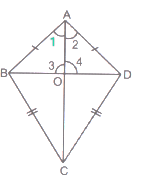
Let diagonals AC & BD intersect at O.
Let, , ,In ∆ABC & ∆ADC, we have :-
AB = AD [Given]
BC = CD [Given]
AC = AC [Common side]
So, By SSS criterion of congruency of triangles , we have[CPCT]
Now, in and , we have :-
AB = AD [Given]
[Proved above]
AO = AO [Common side]
So, By SAS criterion of congruency of triangles , we have :-
[CPCT]
And [CPCT]
But, [Linear pair axiom]
AC is perpendicular bisector of BD. [ and BO = DO]
Hence, proved.
